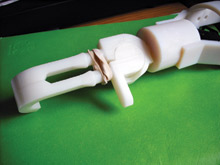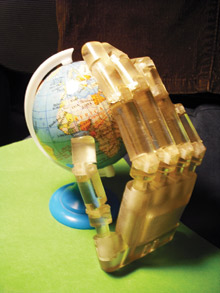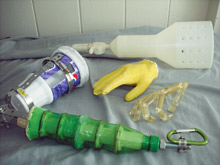
Though the socketless Illini arm concept won’t be revealed until it receives a provisional patent, it will enter user testing this summer. Photographs courtesy of Illini Prosthetics.
A student at the University of Illinois at Urbana-Champaign (UIUC) has won a $30,000 Lemelson-MIT Student Prize for his team’s work to develop a socketless, breathable, wearer-adjustable prosthetic arm for the developing world. The winner, Jonathan Naber, a junior in UIUC’s materials-science and engineering program, heads the Illini Prosthetics team, which includes University of Illinois (UI) students Adam Booher, a junior in engineering mechanics; Richard Kesler, a junior in bioengineering; Luke Jungles, a junior in mechanical engineering; Ehsan Noursalehi, a junior in materials science and engineering; and Hari Vigneswaran, a junior in materials science and engineering.
User-Centered Design
“The unique thing about our project is the way we started looking at the problem,” Naber said. “We stepped back from the classic hook-and-clamp paradigm, and we tried to use a more user-centric view. Combining those elements, I think we’ve been able to overcome a lot of the problems that some prosthetic arms entail, and we’ve been able to identify and produce some solutions to some reasons why prosthetic arms might not succeed in developing countries.”
The Illini team’s transradial prototype, which will undergo user testing in Guatamala this summer, began its life as lists of tasks that users in the developing world need to complete, Naber explained. “We brainstormed how to make this appropriate for developing nations…to serve people who are toiling in the fields, working in hot factories in the middle of undeveloped cities, dealing with extreme heat, extreme cold, dirt, sand, humidity, and water,” he said.
Three Principles
Though the team can’t reveal details on the arm until it receives a provisional patent, Nabor said that the design is based on principles of manufacturablity, breathability, and adjustability. Manufacturability, to Naber’s team, isn’t just about use of very simple shapes that can easily be manufactured by local companies-it’s about entirely eliminating the custom-molded socket.
“We’d like to be able to send a pallet of these prosthetic arms down to Haiti and have an aid worker that we trained for two or three days be able to fit a large volume of them in one day,” Naber said.
As for breathability, the Illini team worked with engineers at the Rehabilitation Institute of Chicago (RIC), Illinois, on interface issues and barriers to compliance. They used the information to create a final design that leaves much of the residual limb’s surface open to aeration.
The team added easy adjustability partly to reduce wearers’ reliance on outsiders. “It means that you don’t need highly trained aid workers to be able to fit a large volume of these, and it also allows amputees to adjust their arms over time. If they find out three months into having their prosthetic arm that it would be more useful if it was two centimeters longer, then they can adjust both its length and fit,” Naber said.
Other Projects
The socketless arm isn’t the team’s only project. David Krupa of the Range of Motion Project (ROMP) is a UI alumnus and has been enthusiastic about the team’s work, Naber said. The brother-in-law of a patient at ROMP’s Zacapa, Guatamala, clinic, had built for her a set of prosthetic fingers made of plastic syringes, and with Krupa’s help, the Illini team is now using computer modeling and rapid prototyping to develop an improvement on the design, which will join a drawing board populated by knee joints, arm iterations, and other prostheses.

The Illini team’s first prototype was a high-tech, multi-articulating hand that was “not the right answer” for the developing world, according to co-inventor Jonathan Naber.
“One of the most important things to note is that we actually didn’t start out super user-centric,” Naber emphasized. “We started out doing the classic engineering mistake of trying to make our project as big and bad as possible, but we realized right away that that was not going to work for people in the developing world. Our first project was a pretty cool piece of technology that might someday have some use in a place like the U.S. or Germany, where there’s plenty of funding….” That first project, a multi-articulating hand, fell to the wayside as the team explored options made entirely of repurposed materials, such as soda bottles and cardboard, then moved toward the current design.

Illini’s early prototypes include arms made entirely of repurposed materials, arms with aerated sockets, a polyurethane cosmetic hand made from a dishwashing glove, and the team’s original, multi-articulating hand.
The final socketless arm iteration may also someday have a cosmesis, as well. “We’ve really focused on functionality and manufacturability at this point,” Naber said, “but we have a couple of cosmesis concepts in the works right now that we think will greatly improve the cosmetic aspect of the arm while still allowing for breathability, which is critical. That will be another one of our big challenges that will really focus on over the summer.”
User Testing
User testing on the arm is scheduled to begin this summer at ROMP’s Zacapa clinic, with multiple users testing a variety of iterations of the arm.
“We’re trying to develop three or four different complete concept arms to take down to Guatemala, and we want to work with as many patients as possible. Again, the beauty of what we’ve done is that the arms can be adjusted to a wide variety of sizes, so we’re hoping to fit many different people with the same exact arm.” The team hopes that children in school, farmers, people caring for their families at home, and others will test the arms for comfort and function.
“We’re trying to serve people who are still on the lowest rung of the socioeconomic ladder,” Naber concluded, “What will work for them is going to be really different from what will work in an air-conditioned office in Chicago, and we’re really excited about what we’ve come up with.”
For more information, visit http://illiniprosthetics.com/




